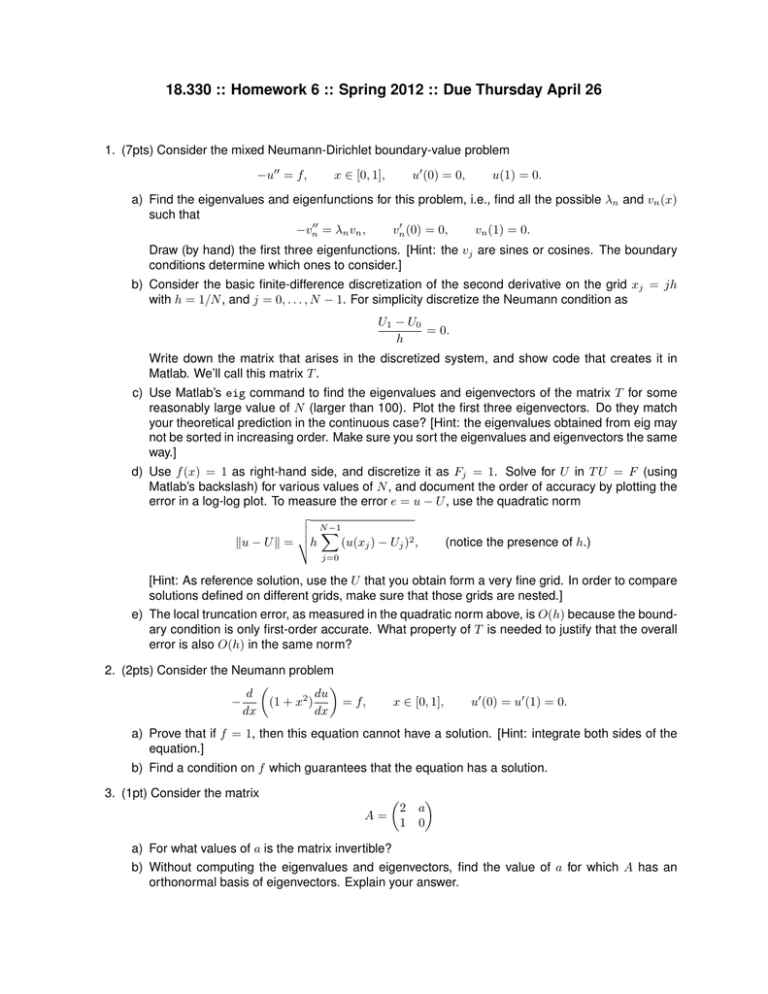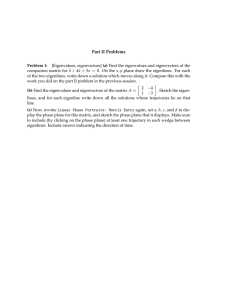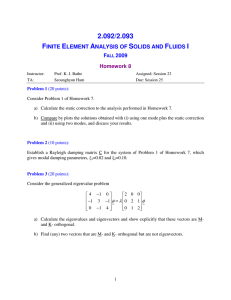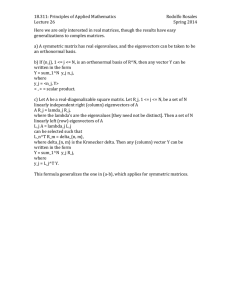18.330 :: Homework 6 :: Spring 2012 :: Due Thursday...
advertisement

18.330 :: Homework 6 :: Spring 2012 :: Due Thursday April 26 1. (7pts) Consider the mixed Neumann-Dirichlet boundary-value problem −u00 = f, x ∈ [0, 1], u0 (0) = 0, u(1) = 0. a) Find the eigenvalues and eigenfunctions for this problem, i.e., find all the possible λn and vn (x) such that −vn00 = λn vn , vn0 (0) = 0, vn (1) = 0. Draw (by hand) the first three eigenfunctions. [Hint: the vj are sines or cosines. The boundary conditions determine which ones to consider.] b) Consider the basic finite-difference discretization of the second derivative on the grid xj = jh with h = 1/N , and j = 0, . . . , N − 1. For simplicity discretize the Neumann condition as U1 − U0 = 0. h Write down the matrix that arises in the discretized system, and show code that creates it in Matlab. We’ll call this matrix T . c) Use Matlab’s eig command to find the eigenvalues and eigenvectors of the matrix T for some reasonably large value of N (larger than 100). Plot the first three eigenvectors. Do they match your theoretical prediction in the continuous case? [Hint: the eigenvalues obtained from eig may not be sorted in increasing order. Make sure you sort the eigenvalues and eigenvectors the same way.] d) Use f (x) = 1 as right-hand side, and discretize it as Fj = 1. Solve for U in T U = F (using Matlab’s backslash) for various values of N , and document the order of accuracy by plotting the error in a log-log plot. To measure the error e = u − U , use the quadratic norm v u N −1 u X (u(xj ) − Uj )2 , (notice the presence of h.) ku − U k = th j=0 [Hint: As reference solution, use the U that you obtain form a very fine grid. In order to compare solutions defined on different grids, make sure that those grids are nested.] e) The local truncation error, as measured in the quadratic norm above, is O(h) because the boundary condition is only first-order accurate. What property of T is needed to justify that the overall error is also O(h) in the same norm? 2. (2pts) Consider the Neumann problem d du − (1 + x2 ) = f, dx dx x ∈ [0, 1], u0 (0) = u0 (1) = 0. a) Prove that if f = 1, then this equation cannot have a solution. [Hint: integrate both sides of the equation.] b) Find a condition on f which guarantees that the equation has a solution. 3. (1pt) Consider the matrix 2 a A= 1 0 a) For what values of a is the matrix invertible? b) Without computing the eigenvalues and eigenvectors, find the value of a for which A has an orthonormal basis of eigenvectors. Explain your answer. MIT OpenCourseWare http://ocw.mit.edu 18.330 Introduction to Numerical Analysis Spring 2012 For information about citing these materials or our Terms of Use, visit: http://ocw.mit.edu/terms.






